Adrian Collins's Blog, page 83
September 13, 2023
REVIEW: Starship Velociraptor by Galactikraken
Starship Velociraptor is a power metal album by Galactikraken (AKA Jonathan Young). Jonathan Young is primarily known for doing metal covers of existing songs on Youtube and you haven’t quite heard the Pokemon theme until you’ve heard it done that way with the original singer co-singing.
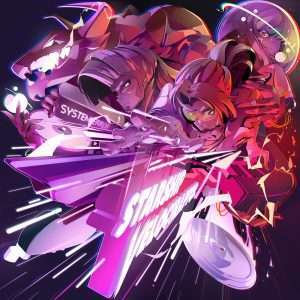 Starship Velociraptor is all original music produced and performed by the singer with the concept of being about a bunch of space pirates in a dystopian future. Congratulations, Jonathan, you have successfully attracted the attention of this man who loves all his metal with either space or fantasy or both.
Starship Velociraptor is all original music produced and performed by the singer with the concept of being about a bunch of space pirates in a dystopian future. Congratulations, Jonathan, you have successfully attracted the attention of this man who loves all his metal with either space or fantasy or both.
Generally, the album is quite good and there’s a lot of experimentation going on. There’s some pirate metal (“Glory or Gold”, “Man the Cannons”, “Settle it with a Swordfight), epic fantasy (“Army of Tigers”, “Storm the Castle”), some cyberpunk music (“Starship Velociraptor”, “Best Band in the Universe”, “Hyperspeed”, “Jetpack Race”, “Final Frontier”), and a beautiful romance ballad (“10,000 Light Years”).
There’s a lot of good songs on this album and I don’t think any of them are skippable. I put “Glory and Gold” and “Man the Cannons” on whenever I want to feel like a space pirate while I think “10,000 Light Years” is probably my all-time favorite love song. I mean, the fact I consider “10,000 Light Years” to be my all-time favorite love song probably says more about me than it does the songs actual merits but a lonely space traveler mourning his girl being across the galaxy with little chance of him getting back to her was surprisingly touching.
If I had to say what the weakest song in the album is, I’d probably go with “Settle it with a Swordfight”, followed by “Hyperspeed.” I simply don’t listen to those songs as much as I listen to the others. The most powerful of the music is definitely “Storm the Castle” about an abused peasantry rising up to kill their king followed by “Final Frontier.”
That’s an anti-global warming song and describes humanity forced to seek a new home after destroying the Earth. But, as mentioned, my favorite of the songs is “10,000 Light Years” and I can’t really overstate how much I love just listening back to the beautiful feelings behind it.
Interestingly, the titular song that sold me on the album in the beginning is one that I have mixed feelings about. “Starship Velociraptor” is literally a song about some people trying to sell a young woman a spaceship. It’s very comedic but also kind of on the tacky side as all sales pitches are. People who enjoy anime, especially 80s cyberpunk anime, would love the Youtube animated video. It’s quite beautiful.
In conclusion, this is a must buy for those people who are both metal as well as science fiction. As the author of both cyberpunk as well as well space pirate fiction, I may be a little TOO much the target audience of this work. However, I think it’s just a fantastic album and I hope the artist will produce more sci-fi metal.
The post REVIEW: Starship Velociraptor by Galactikraken appeared first on Grimdark Magazine.
September 12, 2023
REVIEW: Cyberpunk 2077: No Coincidence by Rafal Kosik
Cyberpunk 2077: No Coincidence is the first novel set in the world of Mike Pondsmith’s Cyberpunk setting. As a huge fan of the tabletop game, I always dreamed of writing my own entry into the dystopian world of Night City and was disappointed there never seemed to be any urge to do as TSR did to create novels set in the world. This has finally changed with the entry by Rafal Kosik. But can anyone truly capture the garish colors of a hyper-stylized city that is otherwise painted in black as well as red? Well, yes, this book does.
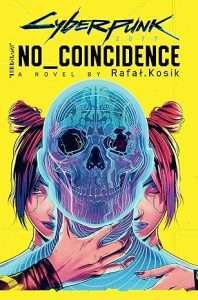 This is a heist book, first and foremost, with a focus on a crew rather than an individual protagonist like V in Cyberpunk 2077. This is probably the best way to experience Night City and one of the failures of the video game since, for the most part, you operate solo with the rare exception of the Relic heist in the first Act of the game. The characters are archetypal but not necessarily stereotypical and the way they bounce off one another reminds me of how quite a few of my Cyberpunk parties were not terribly social with one another. The best of Night City’s gangs are Chooms for life, but these are rare as an honest corpo.
This is a heist book, first and foremost, with a focus on a crew rather than an individual protagonist like V in Cyberpunk 2077. This is probably the best way to experience Night City and one of the failures of the video game since, for the most part, you operate solo with the rare exception of the Relic heist in the first Act of the game. The characters are archetypal but not necessarily stereotypical and the way they bounce off one another reminds me of how quite a few of my Cyberpunk parties were not terribly social with one another. The best of Night City’s gangs are Chooms for life, but these are rare as an honest corpo.
Basically, there’s a former member of the NUSAA (New United States Army), a stripper with a child needing a vital operation to cure her disability (which is not something that one can survive with in Night City), a middle-aged woman who has a lot of money but no thrills, a hacker (sorry, netrunner) who still lives with his mother, a borged out hedonist, and a ripper doc who just wants to upgrade his clientele to sleazy versus ultra sleazy.
This book is a curious mixture of deep characterization and incredibly tense action that doesn’t always completely jive together. A lot of books which open with a huge epic gunfight set the readers to believing that this will be a fast-paced quick read. Instead, this is one of those books you should take the time to savor and soak in the atmosphere. A lot of attention is made to how soul-crushing Zor’s job at demolition is, how slimy Aya finds her job as a stripper (while noting other people don’t seem to mind it), and how even a talented lover is boring when Melina has no emotional connection to the guy whatsoever.
There are some scenes that I felt were a little too stereotypical. Aya turning to stripping and crime because of her sick child before being rescued from an unruly customer by Zor is something that feels a bit too on the nose but doesn’t distract too much from the way Night City is portrayed. Rafal Kosik manages to get the hyper-stylized nature of cyberpunk. There are fantastic toys everywhere but everyone is as miserable as before because they’re only for those people who can afford them. Indeed, people are poorer than ever because the people who make said toys have continued to squeeze a populace that’s apathetic to their own misery.
I also appreciate how unsympathetic our protagonists are while simultaneously being very relatable. Aya is aware that when she kills people on her Edgerunner missions, they’re effectively innocents and she’s doing it for money rather than any cause. There’s no Johnny Silverhand, “Fight the Power!” motivation. She and Zor are the least scummy of their group but they’re not blind to the fact being an Edgerunner means you’re a killer for hire. The only difference between them and the psychopathic heroes of Grand Theft Auto is the possibility of cybernetic upgrades.
I’m a big fan of the Expanded Universe that CDProjekt Red has been creating for some time now. I think this is the one with the most artistic merit (and a lot of them are fantastic). This is a strong R-rating grimdark sort of story and all the better for it. You just know things are going to go to hell before they get better (if they ever do). Still, don’t rush this read. You need to soak in the rainy alleys and smell of garbage before the guy next to you is gunned down in an explosion of blood under a neon sign.
Read Cyberpunk 2077: No Coincidence by Rafal KosikThe post REVIEW: Cyberpunk 2077: No Coincidence by Rafal Kosik appeared first on Grimdark Magazine.
September 11, 2023
REVIEW: Return to Edan by Philip Chase
Finding the right words to describe Return to Edan, the darkest and most ambitious volume of the Edan Trilogy by Philip Chase, feels like an exercise in futility. This final installment of the Edan Trilogy is a book of extraordinary thematic depth, also delivering an unputdownable story with a well-realized cast of relatable characters.
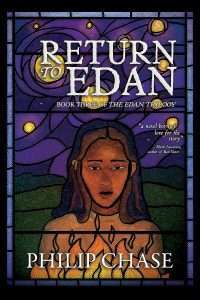 The novel opens with a nine-year-old village boy, Oran, trying to survive in a cruel world following the death of his father. A mysterious figure enters the scene, bringing a sudden transformation to a local thug and demonstrating firsthand the power of the famed Prophet of Edan.
The novel opens with a nine-year-old village boy, Oran, trying to survive in a cruel world following the death of his father. A mysterious figure enters the scene, bringing a sudden transformation to a local thug and demonstrating firsthand the power of the famed Prophet of Edan.
Return to Edan has a melancholy feel reflected in the dark color palette of its stained-glass cover art. The cover depicts a new point-of-view character, the nature-loving girl Seren, who quickly becomes a highlight of the novel. She suffers terrible tragedy but may also hold a key toward salvation. Meanwhile, the sorceress Sequara and her friends are searching for the lead protagonist, Dayraven, who has lost his identity and much of his memory in becoming the fated Prophet of Edan.
The first two books of the trilogy, The Way of Edan and The Prophet of Edan, leaned heavily into a Buddhist-influenced journey of self-discovery. Return to Edan retains this Buddhist influence but also serves as a Christ allegory with numerous Biblical parallels. As Dayraven travels the land, he preaches very Christ-like lessons on the importance of love:
“The path of love is not always easy, and it is not always clear, though it will reward you like no other. You may stumble away from it at times, but it is always awaiting your return. It requires courage and determination to stay on it. You must be true to yourself and your deepest beliefs. Most of all, it requires being the person you choose to love.”
Dayraven also uses his powers to reveal the sins of evildoers, forcing them to confront the horrors of their own actions:
“A long wail escaped the king’s mouth, which gaped in a rictus of agony. When his scream ceased, the man gasped for breath as he knelt and stared ahead with eyes that did not see.”
There is clear Biblical inspiration for this from both the Old Testament, “Though his hatred covers itself with guile, his wickedness will be revealed before the assembly” (Proverbs 26:26), and the New Testament, “But there is nothing covered up that will not be revealed, and hidden that will not be known” (Luke 12:2).
But Philip Chase has given a grimdark twist to the typical Christ allegory, since the source of Dayraven’s powers is not goodness but rather a morally ambiguous elven power that could be evil in nature or simply indifferent to the affairs of humanity.
Dayraven’s power is not an intrinsic part of his existence: it is something foreign to him, embedded in his being, constantly threatening to take over. Dayraven wrestles mightily with the internal struggle that this creates, trying to harness the elven power for good. In this way, Philip Chase has also captured the essence of Frodo’s conflict in J.R.R. Tolkien’s The Lord of the Rings, another Christ allegory where the power of the One Ring is an evil that threatens to consume Frodo’s own identity.
Like Frodo, Dayraven must consider if he is willing and able to make the ultimate sacrifice for others. Humanity is capable of such deep love and beauty but also terrifying evils. After the War of the Way from the last book, the world of Return to Edan is rife with violence and disease. An outside observer like the elf might justifiably ponder if a species that has caused so much suffering and destruction is truly worth saving. Is humanity just an irredeemable cancer on the face of the planet?
Grimdark fans will find much to love in Return to Edan. Set in a dark and brutal world, Philip Chase doesn’t shy away from realistic depictions of violence and the shadows of war. The rawness depicted in several scenes made me wince in pain. There is also moral ambiguity, as Dayraven’s powers are both wondrous and terrifying: he could end up being either a savior or a destroyer. In this sense, Philip Chase threatens to subvert the chosen one trope in a manner that could potentially go the way of Frank Herbert’s Dune Messiah.
Continuing the trend in the characters’ personal journeys, both eastern and western theologies are reflected in Philip Chase’s concept of Edan, which seems to encompass both the Buddhist notion of nirvana and the Biblical notion of paradise (“Eden”) as a state without suffering or sin. But Chase also astutely captures the inherent tension between loving human attachments and the emotional detachment required to achieve such a state.
My review barely scratches the surface of Return to Edan. The Edan Trilogy can be read on multiple levels, and a complete analysis is more worthy of a Ph.D. dissertation than a short review such as this. But putting aside such in-depth analysis, I should emphasize that Philip Chase also delivers a perfectly paced story with beautiful prose and engaging, empathetic characters.
Taken as a whole, the Edan Trilogy is a modern masterpiece, a lamentation as timeless and beautiful as the stained glass depicted on each of its three covers. With the Edan Trilogy, Philip Chase proves that fantasy can achieve the highest echelon of literary greatness while delivering a gripping story, epic in scope and deeply personal in its impact.
5/5
Read Return to Edan by Philip ChaseThe post REVIEW: Return to Edan by Philip Chase appeared first on Grimdark Magazine.
Review: Return to Edan by Philip Chase
Finding the right words to describe Return to Edan, the darkest and most ambitious volume of the Edan Trilogy by Philip Chase, feels like an exercise in futility. This final installment of the Edan Trilogy is a book of extraordinary thematic depth, also delivering an unputdownable story with a well-realized cast of relatable characters.
 The novel opens with a nine-year-old village boy, Oran, trying to survive in a cruel world following the death of his father. A mysterious figure enters the scene, bringing a sudden transformation to a local thug and demonstrating firsthand the power of the famed Prophet of Edan.
The novel opens with a nine-year-old village boy, Oran, trying to survive in a cruel world following the death of his father. A mysterious figure enters the scene, bringing a sudden transformation to a local thug and demonstrating firsthand the power of the famed Prophet of Edan.
Return to Edan has a melancholy feel reflected in the dark color palette of its stained-glass cover art. The cover depicts a new point-of-view character, the nature-loving girl Seren, who quickly becomes a highlight of the novel. She suffers terrible tragedy but may also hold a key toward salvation. Meanwhile, the sorceress Sequara and her friends are searching for the lead protagonist, Dayraven, who has lost his identity and much of his memory in becoming the fated Prophet of Edan.
The first two books of the trilogy, The Way of Edan and The Prophet of Edan, leaned heavily into a Buddhist-influenced journey of self-discovery. Return to Edan retains this Buddhist influence but also serves as a Christ allegory with numerous Biblical parallels. As Dayraven travels the land, he preaches very Christ-like lessons on the importance of love:
“The path of love is not always easy, and it is not always clear, though it will reward you like no other. You may stumble away from it at times, but it is always awaiting your return. It requires courage and determination to stay on it. You must be true to yourself and your deepest beliefs. Most of all, it requires being the person you choose to love.”
Dayraven also uses his powers to reveal the sins of evildoers, forcing them to confront the horrors of their own actions:
“A long wail escaped the king’s mouth, which gaped in a rictus of agony. When his scream ceased, the man gasped for breath as he knelt and stared ahead with eyes that did not see.”
There is clear Biblical inspiration for this from both the Old Testament, “Though his hatred covers itself with guile, his wickedness will be revealed before the assembly” (Proverbs 26:26), and the New Testament, “But there is nothing covered up that will not be revealed, and hidden that will not be known” (Luke 12:2).
But Philip Chase has given a grimdark twist to the typical Christ allegory, since the source of Dayraven’s powers is not goodness but rather a morally ambiguous elven power that could be evil in nature or simply indifferent to the affairs of humanity.
Dayraven’s power is not an intrinsic part of his existence: it is something foreign to him, embedded in his being, constantly threatening to take over. Dayraven wrestles mightily with the internal struggle that this creates, trying to harness the elven power for good. In this way, Philip Chase has also captured the essence of Frodo’s conflict in J.R.R. Tolkien’s The Lord of the Rings, another Christ allegory where the power of the One Ring is an evil that threatens to consume Frodo’s own identity.
Like Frodo, Dayraven must consider if he is willing and able to make the ultimate sacrifice for others. Humanity is capable of such deep love and beauty but also terrifying evils. After the War of the Way from the last book, the world of Return to Edan is rife with violence and disease. An outside observer like the elf might justifiably ponder if a species that has caused so much suffering and destruction is truly worth saving. Is humanity just an irredeemable cancer on the face of the planet?
Grimdark fans will find much to love in Return to Edan. Set in a dark and brutal world, Philip Chase doesn’t shy away from realistic depictions of violence and the shadows of war. The rawness depicted in several scenes made me wince in pain. There is also moral ambiguity, as Dayraven’s powers are both wondrous and terrifying: he could end up being either a savior or a destroyer. In this sense, Philip Chase threatens to subvert the chosen one trope in a manner that could potentially go the way of Frank Herbert’s Dune Messiah.
Continuing the trend in the characters’ personal journeys, both eastern and western theologies are reflected in Philip Chase’s concept of Edan, which seems to encompass both the Buddhist notion of nirvana and the Biblical notion of paradise (“Eden”) as a state without suffering or sin. But Chase also astutely captures the inherent tension between loving human attachments and the emotional detachment required to achieve such a state.
My review barely scratches the surface of Return to Edan. The Edan Trilogy can be read on multiple levels, and a complete analysis is more worthy of a Ph.D. dissertation than a short review such as this. But putting aside such in-depth analysis, I should emphasize that Philip Chase also delivers a perfectly paced story with beautiful prose and engaging, empathetic characters.
Taken as a whole, the Edan Trilogy is a modern masterpiece, a lamentation as timeless and beautiful as the stained glass depicted on each of its three covers. With the Edan Trilogy, Philip Chase proves that fantasy can achieve the highest echelon of literary greatness while delivering a gripping story, epic in scope and deeply personal in its impact.
5/5
Read Return to Edan by Philip ChaseThe post Review: Return to Edan by Philip Chase appeared first on Grimdark Magazine.
September 10, 2023
REVIEW: Ice Cream Man #36 by W. Maxwell Prince (W) and Martin Morazzo (A)
Ice Cream Man #36 is one shot tale of loss and grief and madness. I’ve been reading Ice Cream Man since its inception. What the writer W Maxwell Prince and artist Martin Morazzo have done with this series is an utter marvel. Tales of existential horror, of suburban alienationloss, of creeping dread that takes you in the night and rips you from existence. Each of these titles has been a masterclass in creating, maintaining and paying off an escalation of terror sufficient to make the reader peer uncertainly over their shoulder during the reading experience.
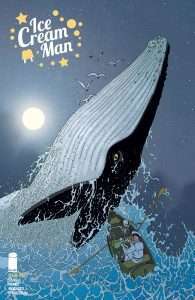 Ice Cream Man #36 is no different. Outwardly, however, it isn’t your usual tale of horror. There is no gore, no Great Old Ones looming over the rim of the galaxy, no masked madmen ready to eviscerate their way through a party of drunken horny teenagers. Aliens spewing acid are absent, dollies with knives running rampant are absent. But what isn’t absent is a tautly told tale of madness, a story about a father’s grief, and what overwhelming regret can do to the human mind.
Ice Cream Man #36 is no different. Outwardly, however, it isn’t your usual tale of horror. There is no gore, no Great Old Ones looming over the rim of the galaxy, no masked madmen ready to eviscerate their way through a party of drunken horny teenagers. Aliens spewing acid are absent, dollies with knives running rampant are absent. But what isn’t absent is a tautly told tale of madness, a story about a father’s grief, and what overwhelming regret can do to the human mind.
Madness is the horror here.
Winslow is a doughty fisherman, a hunter who nightly braves the ocean deeps – it is his obsession, an obsession that has ruined his relationship with his daughter. Yet when that self same daughter vanishes on the water, her disappearance shatters his mind. Ice Cream Man #36 opens with Winslow narrating a letter, out loud, to himself, to the consternation of his fellow villagers. He vows to find his daughter, and after buying a bucket of chum, rows out of the harbour and into…myth.
Swallowed Jonah-like by a whale, Winslow finds himself inside the belly of the beast, in a horror show of naked people riding in bathtubs, of a talking wooden doll and of a heroically moustachioed peg-legged sailor who goads and insults him as he stumbles from one bizarre encounter after another, until the search comes to a mind shattering conclusion.
Whether Winslow is insane or the victim of occult forces beyond the reason of mere man is left up to the reader. What I do know is that in Ice Cream Man #36, artist Martin Morazzo’s artwork has never been better. The meticulousness of his vision, the way he dominates each panel with scarifying detail, is a masterclass in how art can evoke mood and atmosphere, and indeed, fear itself. Winslow finds himself in a world that cannot be, yet Morazzo makes it as vital and alive as any other artist in the industry today. That might be the Titanic in the back of one panel, occupying a space far larger than a whale’s belly might be thought of capable of holding, but it is the least strange detail in Ice Cream Man #36.
Come for the madness, and spend the rest of your time going over and over the panel for the intricate details Morazzo brings to his work.
Ice Cream Man #36 is a horror tale, but a horror tale of the mind. While other issues of Ice Cream Man dabble in the horrors beneath the surface of ordinary life, Ice Cream Man #36 instead goes beneath the hopelessly thin scrim of the world, and the even thinner surface of the human mind, to find the horror of loss and grief buried shallowly within us all. Who knows, dear reader…you might one day find yourself in the belly of your own beast. How loudly will you scream?
5/5 stars
Read Ice Cream Man #36 by W Maxwell Prince (W) and Martin Morazzo (A)The post REVIEW: Ice Cream Man #36 by W. Maxwell Prince (W) and Martin Morazzo (A) appeared first on Grimdark Magazine.
September 9, 2023
REVIEW: The Graveyard Shift by Maria Lewis
Tinsel Munroe is the host of “The Graveyard Shift,” an overnight horror-themed radio show on 102.8 HitsFM, Melbourne’s hottest station. Despite her best efforts she finds herself mostly treading water in her career, trapped in a dead-end time slot playing for a devoted but small following. Her life is upended on Halloween, however, when an audience member is viciously murdered during a broadcast phone call. New listeners flock to the show with ghoulish hopes for another on-air killing, and ominous messages reveal to Tinsel that she herself is a target. As the police investigation founders and the body count rises, Tinsel realizes that her continued survival depends on her ability—with assistance from her true crime blogger sister Pandora and the handsome detective Vic James—to uncover the hidden connection between herself and the unseen assailant.
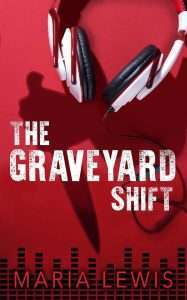 The Graveyard Shift is billed as an “homage” to the slasher movies of the 1990s, and elements of the Scream series are certainly present and accounted for. While Halloween, A Nightmare on Elm Street, Child’s Play and various other slasher franchises are name-checked throughout the book, potential readers should be aware that The Graveyard Shift is more of a thriller with light mystery and romance elements than a horror novel. The supernatural is not a factor, and Maria Lewis does not devote much effort to building and sustaining an unsettling or frightening atmosphere. That being said, the murder scenes are tense and exciting and deliver the sort of gore one would expect from I Know What You Did Last Summer or similar slashers.
The Graveyard Shift is billed as an “homage” to the slasher movies of the 1990s, and elements of the Scream series are certainly present and accounted for. While Halloween, A Nightmare on Elm Street, Child’s Play and various other slasher franchises are name-checked throughout the book, potential readers should be aware that The Graveyard Shift is more of a thriller with light mystery and romance elements than a horror novel. The supernatural is not a factor, and Maria Lewis does not devote much effort to building and sustaining an unsettling or frightening atmosphere. That being said, the murder scenes are tense and exciting and deliver the sort of gore one would expect from I Know What You Did Last Summer or similar slashers.
The Graveyard Shift’s greatest strength is its characters. Tinsel is a likable, smart, and resourceful heroine. True crime blogger Pandora and police detective Vic James are likewise appealing, and even the minor supporting characters come across as distinctive, well-rendered individuals. While it feels a little convenient that Tinsel’s sister happens to be a serial killer expert with police connections and a ready supply of murder factoids, Pandora is given enough fleshing-out to make her more than just a convenient plot device. Dreamy, stubbled protector Detective James also seems more like a Hollywood cop than somebody one would encounter on a real world police force, but he is given enough depth to transcend his primary function as hunky daydream fodder for readers. The characters are fun, and it’s enjoyable spending time with them.
In The Graveyard Shift, Lewis writes in a breezy, thoroughly modern voice. The book is fast-paced and engaging, but I struggled a bit with the tone. At no point in this book does someone narrowly escape from a knife-wielding maniac and then brush it off with a quippy “Well, that happened,” but if a scene like that HAD been present it would not have been out of place with the rest of the book. Plucky bravery is one thing, but Tinsel comes off as remarkably unflappable for someone being actively stalked by a serial killer. She shows occasional moments of fright or doubt, but is otherwise largely able to go about her life in good spirits, mostly covering her regular shift at work and putting in appearances at social functions. The constantly shifting tone threw me off, but it feels significant that a main character is a true crime enthusiast. True crime podcasts and blogs are often accused of trivializing real world brutality and murder for the sake of salacious thrills, and similarly the fictional crimes depicted here aren’t always handled with the utmost gravity. Tinsel is appropriately devastated when people she knows are attacked, but at times it feels like the deaths of unacquainted victims are treated more like a fun puzzle to be solved by Tinsel and Pandora: Taskforce Laurie Strode.
The Graveyard Shift is an energetic and stimulating thriller. Readers hoping for grit and angst are better off looking elsewhere, but this book serves well as a refreshing palate cleanser after finishing weightier fare.
Read The Graveyard Shift by Maria LewisThe post REVIEW: The Graveyard Shift by Maria Lewis appeared first on Grimdark Magazine.
September 8, 2023
REVIEW: The Division: Broken Dawn by Alexander C. Irving
The Division: Broken Dawn by Alexander C. Irving is a volume in the Ubisoft post-apocalypse action series, The Division. It is an intequel set between the events of the first two games. The premise of The Division games are that the world has been ravaged by a virus called the Dollar Flu. The exact number of people that have died is unknown but it is enough that cities are now largely abandoned as well as filled with roving bands of humans fighting for survival. Pretty much like The Walking Dead but without zombies. It is also under the Tom Clancy label, which means that it is vaguely spy themed and makes a very bare bones pretense at realism.
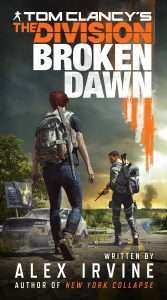 The premise for Broken Dawn is that we follow the perspectives of four survivors as they deal with an interlocked story, Quentin Tarantino style. The primary star is April Kelleher, a widow whose husband was a biologist that may have created the cure for the Dollar Flu. Violet is a child who lives in the Smithsonian Castle that has been turned into a colony for survivors of Washington D.C. Aurelio Diaz is a Division agent who has begun pursuing another agent, Ike Ronson, for abandoning his duty. Ike is the final perspective as he’s betrayed his oaths as a Division agent to work for a mysterious new employer.
The premise for Broken Dawn is that we follow the perspectives of four survivors as they deal with an interlocked story, Quentin Tarantino style. The primary star is April Kelleher, a widow whose husband was a biologist that may have created the cure for the Dollar Flu. Violet is a child who lives in the Smithsonian Castle that has been turned into a colony for survivors of Washington D.C. Aurelio Diaz is a Division agent who has begun pursuing another agent, Ike Ronson, for abandoning his duty. Ike is the final perspective as he’s betrayed his oaths as a Division agent to work for a mysterious new employer.
Unlike Hearts of Fire, Broken Dawn decides to tell a much more continuity-heavy story that doesn’t deal with the personal elements of being trapped in a post-apocalyptic world. There, the story was about a pair of sisters finding themselves on opposing sides while the world fell apart around them. Here, we have lots of allusions to the quest for the broad spectrum anti-virus, the Black Tusk conspiracy, and the rogue agent network.
This isn’t necessarily a bad thing as the kind of people who are going to pick up this book are the kind of people who, presumably, are ones who are fans of the Division world. Unfortunately, it does make this a poor entry for people who are first getting into the Division and want to try to do so with the novels rather than the games. The story still holds up without the knowledge of the games but you lose a lot of the context with April Kelleher from the first game’s side quests as well as who Ike’s mysterious employer is.
The biggest boon of the novel is definitely the fact that it actually takes us outside of New York and Washington D.C. for a time. We get to see what’s happening in other states like Pittsburgh, Michigan, and rural America. While this is the basis for the upcoming The Division: Heartand, this is right now the biggest indication of how the rest of the world is dealing with the Dollar Flu. The rest of America is actually doing a bit better than the two major cities but not without their own problems. Much of America is returning to 19th century levels of technology to deal with the disruption to supply lines.
Unfortunately, the book does have a few flaws. Violet and the other children just aren’t that interesting as they are fairly normal adolescents in the apocalypse. Which means useless. They also don’t have much of a major effect on the plot as well. The book also just sort of ends with very little resolution of the major plots. This wouldn’t be a problem if we were going to have a sequel planned or this was part one of a trilogy but Broken Dawn feels very much like the author was telling us to buy The Division 2. Still, I overall enjoyed it as a Division fan.
Read The Division: Broken Dawn by Alexander C. IrvingThe post REVIEW: The Division: Broken Dawn by Alexander C. Irving appeared first on Grimdark Magazine.
September 7, 2023
REVIEW: A Book of Blades: Volume II
Sequel to 2022’s A Book of Blades, A Book of Blades: Volume II is the second anthology of fiction curated by the crew of Rogues in the House: The Ultimate Sword & Sorcery Podcast. It includes 14 Sword & Sorcery-themed short stories by as many authors, with striking cover artwork by Jesus Garcia and internal illustrations by Gilead. Writers featured here have appeared in the pages of short fiction venues like Tales From The Magician’s Skull, Old Moon Quarterly, and Savage Realms Monthly, so this anthology also serves as a broad survey of more than a dozen authors active in the indie S&S scene.
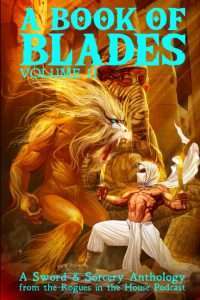 As a Sword & Sorcery anthology, most of the stories deal with either lone heroes or small bands (here frequently drifters, tomb raiders, or mercenaries between jobs) thrust into deadly situations, relying on their wits and weaponry to defeat supernatural threats. The protagonists generally aren’t embarking on epic quests, they’re seeking riches, revenge, or simply attempting to survive. The tone is almost universally gritty and violent across the collected stories, with several selections comfortably grimdark in everything but name. This review focuses on A Book of Blades: Volume II’s darker entries.
As a Sword & Sorcery anthology, most of the stories deal with either lone heroes or small bands (here frequently drifters, tomb raiders, or mercenaries between jobs) thrust into deadly situations, relying on their wits and weaponry to defeat supernatural threats. The protagonists generally aren’t embarking on epic quests, they’re seeking riches, revenge, or simply attempting to survive. The tone is almost universally gritty and violent across the collected stories, with several selections comfortably grimdark in everything but name. This review focuses on A Book of Blades: Volume II’s darker entries.
“Breaching Earth’s Womb” by S.E. Lindberg is one of the most grimdark and all-around weirdest stories included in A Book of Blades: Volume II. When tainted pregnancies result in several expectant mothers being eviscerated and consumed by insectoid parasites, golem midwife Nurse Leech must leave the relative safety of home to ward off a larger disaster. Her desperate journey takes her across a blasted land ravaged by an ongoing struggle between immense, godlike beings. Lindberg is fascinated by the concept of the ancient Greek bodily humors and the maladies thought to result from imbalances between them, and this story shows the same bizarrely compelling gooey, squidgy body horror of the other tales in his Dyscrasia Fiction line.
“Beasts of Waste & Desolation” features the Viking-era orc hero of Scott Oden’s grimdark Grimnir trilogy (A Gathering of Ravens, Twilight of the Gods, and the forthcoming The Doom of Odin). Back in Jutland after slaughtering “whiteskin” humans abroad, Grimnir encounters a crone doing her laundry in a shallow pool. Recognizing her as a deadly water spirit in disguise, he helps himself to her banquet while participating in a high-stakes game of riddles. The story that follows is an entertainingly predatory tête-à-tête in which two lethal killers circle each other, simultaneously probing for weaknesses and coiling to strike.
“Cries from a Sleeping City,” by Grimdark Magazine contributor and Rogues in the House podcaster Matt John, is another adventure featuring barbarian mercenary Lachmannon (previously seen in issue 10 of Tales From The Magician’s Skull). The wealthy ruler of Zanzara hires a tavern full of sell-swords to scour the tunnels beneath the city, searching for the mythical Queen Vashka, thought to be an imprisoned immortal sorceress. Initially skeptical of the task, Lachmannon quickly learns that the tales of Vashka are true. To survive, he must fight to escape a nightmarish subterranean hellscape filled with cannibalistic “eaters” and unseen lurkers that use body-invading tentacles to drive their victims insane with bloodlust. The story is fast paced, with a fun menagerie of monsters and a dark streak a mile wide.
John R. Fultz’s “Return of the Quill” is another moody standout in A Book of Blades: Volume II. The necromancer Grimsort, one of eight Sorcerer Kings ruling a conquered city policed by revived corpses, is persuaded to allow a traveling acting troupe to stage a play in his domain. His fellow tyrants plan to sacrifice the massive audience as fuel for a demonic summoning, but Grimsort finds himself unexpectedly swayed by the actors’ bravura performance. While not particularly lengthy, this story is rich with gothic imagery and fascinating characters. Its celebration of the power storytelling can have even over the most hardened heart also appealed.
A Book of Blades: Volume II concludes with “The Horror from the Stars,” by Steve Dilks. Like Charles Clark’s “The White Tower” at the very beginning of the anthology and “The Geomancer’s Son” by J. Thomas Howard, this story involves a close encounter with a threat from outer space. (The Sword & Sorcery subgenre predates the firmer separation of fantasy from science fiction to which modern readers have grown accustomed, and I have a particular soft spot for warrior vs. alien stories.) “The Horror from the Stars” begins with Bohun arriving in the city of Ibn-Shahk, determined to reclaim his abducted wife from the sultan’s harem or die trying. He’s warned of a string of mysterious disappearances since the sultan’s retrieval of a “fallen star” from the desert, and soon comes face-to-face with the sadistic otherworldly intelligence behind the throne. While Bohun’s final triumph felt a little too easily attained given what we’re shown of the alien’s capabilities, both the action and horrific elements are exciting and cinematically presented.
While some contributions are reprints from other venues and I was slightly disappointed that the artwork didn’t directly tie to the included stories, A Book of Blades: Volume II feels like an enthusiastic labor of love. Brisk action is the hallmark of these stories, and there’s more than enough here to justify the purchase for fans of grimdark fantasy.
Read A Book of Blades: Volume IIThe post REVIEW: A Book of Blades: Volume II appeared first on Grimdark Magazine.
September 6, 2023
REVIEW: The Forbidden Realms by H.C. Newell
H.C. Newell puts the fun back in dark fantasy with The Forbidden Realms, the exhilarating second volume of her Fallen Light series and the follow-up to her highly accomplished debut novel, Curse of the Fallen. I will keep this review 100% spoiler-free for people who have not yet read Curse of the Fallen.
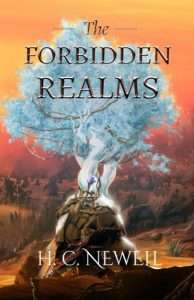 As in Curse of the Fallen, the lead heroine of the story is Nerana Leithor, or Neer for short, a young woman imbued with magical powers, including the ability to teleport short distances. But magic is forbidden in the land of Laeroth, making Neer the target of religious fanatics and rulers in the human-controlled territories.
As in Curse of the Fallen, the lead heroine of the story is Nerana Leithor, or Neer for short, a young woman imbued with magical powers, including the ability to teleport short distances. But magic is forbidden in the land of Laeroth, making Neer the target of religious fanatics and rulers in the human-controlled territories.
Neer is an absolute joy to read: strong but vulnerable, funny but with a deep-seated sadness carrying over from events in the first book. In The Forbidden Realms, Neer finds herself stranded in the desert wastelands of Aragoth without any of her companions from Curse of the Fallen.
The Forbidden Realms introduces us to a new point-of-view character, the powerful elvish sorceress Aélla, as well as a delightful cast of supporting characters who have more than a few surprises in store for our heroine. I must admit, I was a bit skeptical about getting a whole new setting and cast of characters in The Forbidden Realms, but I quickly became attached to the new characters and their rip-roading adventure.
The Forbidden Realms is much faster paced compared to Curse of the Fallen. H.C. Newell delivers a constant stream of action which keeps the reader on the edge of their seat:
“Neer curled on top of the ground, gasping for breath. The burning in her veins had reduced to a low simmering heat. Her muscles were rigid and hard to move, and she reached shakily for her sword, just out of reach.”
Beyond the heart-pounding action scenes, there are also plenty of emotional moments:
“Leaning onto his shoulder, she closed her eyes and was comforted by his embrace as he wrapped his arm around her back. They sat in a comfortable silence for the rest of the morning, and for the first time in months, she knew she wasn’t alone.”
H.C. Newell is a natural storyteller, and her writing is the perfect match for this dark tale. The story includes some rather gruesome action scenes that are never gratuitous but will delight even the most skeptical grimdark reader.
Newell’s worldbuilding in The Forbidden Realms is also outstanding, a Tolkienesque nightmare with an undercurrent of Lewis Carroll’s Alice’s Adventures in Wonderland. Newell builds an impressive depth of lore in her series, with plenty of nuance and Easter eggs that will reward the careful reader.
I still have mixed feelings about Newell’s use of footnotes to explain some of the worldbuilding elements. While it’s great to learn these additional pieces of history and lore, it would have been preferable to incorporate this information into the main text of the novel somehow.
H.C. Newell improves upon her craft in every way with The Forbidden Realms, delivering a fast-paced epic adventure that is equal parts dark and delicious. The Fallen Light series will continue with the third book, Shadows of Nyn’Dira, where the action shifts to the dark elven forests of Nyn’Dira.
4.5/5
Read The Forbidden Realms by H.C. NewellThe post REVIEW: The Forbidden Realms by H.C. Newell appeared first on Grimdark Magazine.
REVIEW: The Forbidden Realms by H.C. Newel
H.C. Newell puts the fun back in dark fantasy with The Forbidden Realms, the exhilarating second volume of her Fallen Light series and the follow-up to her highly accomplished debut novel, Curse of the Fallen. I will keep this review 100% spoiler-free for people who have not yet read Curse of the Fallen.
 As in Curse of the Fallen, the lead heroine of the story is Nerana Leithor, or Neer for short, a young woman imbued with magical powers, including the ability to teleport short distances. But magic is forbidden in the land of Laeroth, making Neer the target of religious fanatics and rulers in the human-controlled territories.
As in Curse of the Fallen, the lead heroine of the story is Nerana Leithor, or Neer for short, a young woman imbued with magical powers, including the ability to teleport short distances. But magic is forbidden in the land of Laeroth, making Neer the target of religious fanatics and rulers in the human-controlled territories.
Neer is an absolute joy to read: strong but vulnerable, funny but with a deep-seated sadness carrying over from events in the first book. In The Forbidden Realms, Neer finds herself stranded in the desert wastelands of Aragoth without any of her companions from Curse of the Fallen.
The Forbidden Realms introduces us to a new point-of-view character, the powerful elvish sorceress Aélla, as well as a delightful cast of supporting characters who have more than a few surprises in store for our heroine. I must admit, I was a bit skeptical about getting a whole new setting and cast of characters in The Forbidden Realms, but I quickly became attached to the new characters and their rip-roading adventure.
The Forbidden Realms is much faster paced compared to Curse of the Fallen. H.C. Newell delivers a constant stream of action which keeps the reader on the edge of their seat:
“Neer curled on top of the ground, gasping for breath. The burning in her veins had reduced to a low simmering heat. Her muscles were rigid and hard to move, and she reached shakily for her sword, just out of reach.”
Beyond the heart-pounding action scenes, there are also plenty of emotional moments:
“Leaning onto his shoulder, she closed her eyes and was comforted by his embrace as he wrapped his arm around her back. They sat in a comfortable silence for the rest of the morning, and for the first time in months, she knew she wasn’t alone.”
H.C. Newell is a natural storyteller, and her writing is the perfect match for this dark tale. The story includes some rather gruesome action scenes that are never gratuitous but will delight even the most skeptical grimdark reader.
Newell’s worldbuilding in The Forbidden Realms is also outstanding, a Tolkienesque nightmare with an undercurrent of Lewis Carroll’s Alice’s Adventures in Wonderland. Newell builds an impressive depth of lore in her series, with plenty of nuance and Easter eggs that will reward the careful reader.
I still have mixed feelings about Newell’s use of footnotes to explain some of the worldbuilding elements. While it’s great to learn these additional pieces of history and lore, it would have been preferable to incorporate this information into the main text of the novel somehow.
H.C. Newell improves upon her craft in every way with The Forbidden Realms, delivering a fast-paced epic adventure that is equal parts dark and delicious. The Fallen Light series will continue with the third book, Shadows of Nyn’Dira, where the action shifts to the dark elven forests of Nyn’Dira.
4.5/5
Read The Forbidden Realms by H.C. NewelThe post REVIEW: The Forbidden Realms by H.C. Newel appeared first on Grimdark Magazine.



